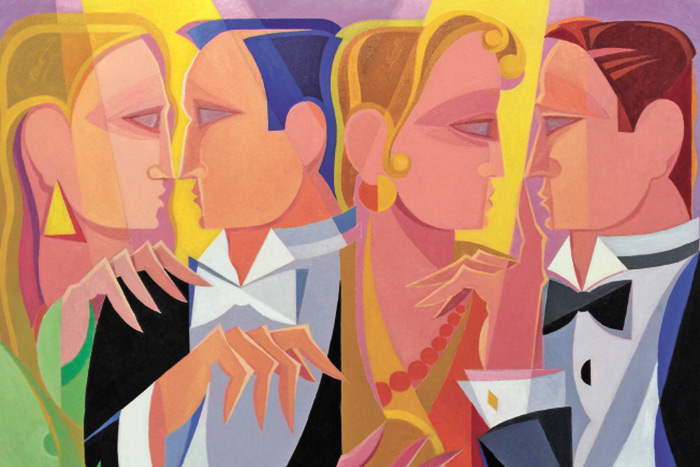Celebrate the New Year with Dan's Papers Cover Artist Giancarlo Impiglia

If you’re unfamiliar with the work of this week’s cover artist, Giancarlo Impiglia, boy are you missing out.
Though, to be sure, you may know more of his work than you’re aware of—his exhibition at the Southampton Cultural Center this past summer was well attended and well received; his 1992 Absolut Vodka ad, Absolut Impiglia, sets itself apart nicely from the other 1,500 ads in that campaign; The Queen Elizabeth, Queen Mary II and Queen Victoria cruise ships all feature his work; and a handful of his murals adorn New York cityscapes, including the lobby of 99 John Street.
His decades-spanning oeuvre consists of countless paintings and sculptures—aluminum and wood, jig-sawed and painted like his canvases—carefully crafted with their sharp lines, bold colors and featureless characters. But there’s more to Impiglia and his work, so we headed out to his Bridgehampton studio recently to find out more about the internationally renowned artist, painting away in our own backyard.

Impiglia’s studio, custom-made for its purpose, was a clutter of boxes at the time, as he was in the midst of packing up work to send to Miami for an upcoming exhibition. Upon entering, one’s eye is drawn immediately to a large, older piece—an assemblage of blue jeans mounted on canvas hung above the concrete floor the artist paints over. It’s a subtle political statement from an always subversive, class-conscious artist. From those blue jean assemblages to the blank-faced and emotionless characters, stylishly dressed in the costumes that swanky holiday parties require of us, Impiglia’s every work is a critique of modern society.
We’re always wearing costumes, presenting ourselves in a way the world wants to see us whether that’s how we want to be seen or not. Case in point: this writer in his ill-fitting reporter’s garb. And the blank faces? Impiglia paints situations, not portraits. And onto those blank faces, the viewer, and the other characters present in the painting alike, are free to project whatever they wish, just like in real life.
Perhaps to fully understand and appreciate the work of Impiglia, one must have at least a passing familiarity with the revolutionary artistic and social movements inspired by the social upheavals of the late 19th and early 20th century. Italian Futurism experimented with the fragmentation of form as representation of newly unleashed speed, flight, movement and machines. Futurism developed at the same time Picasso was working on Cubism in France. Then Suprematism was unveiled in 1915 Russia at “The Last Futurist Exhibition of Paintings,” followed by the Dada movement, founded by Hugo Ball in Zürich in 1916, the most famous example of which might be Duchamp’s “Fountain” (a urinal turned on its head). All of these, of course, were direct ancestors to Pollock’s Abstract Expressionism, the Art Deco theater façade now missing from Main Street in Sag Harbor and Lichtenstein’s Pop Art. Which is to say, we love this stuff on the East End.
The common theme of these movements is the complete destruction of bourgeois art. “At last,” Filippo Marinetti wrote in his seminal 1909 text The Manifesto of Futurism, “mythology and the mystic cult of the ideal have been left behind.” Gone were the sentimental cherubs and religious scenes, the neat portraits of merchant’s wives draped in finery. All of this new art would show us what the world really looked like—chaos broken into a million pieces. It was the beginning of Modernist art! And while, upon first glance, Impiglia’s work does not look like a world rapt by chaos, one would be wise to take a closer look.
For more about Giancarlo Impiglia and his work, visit giancarloimpiglia.com.




